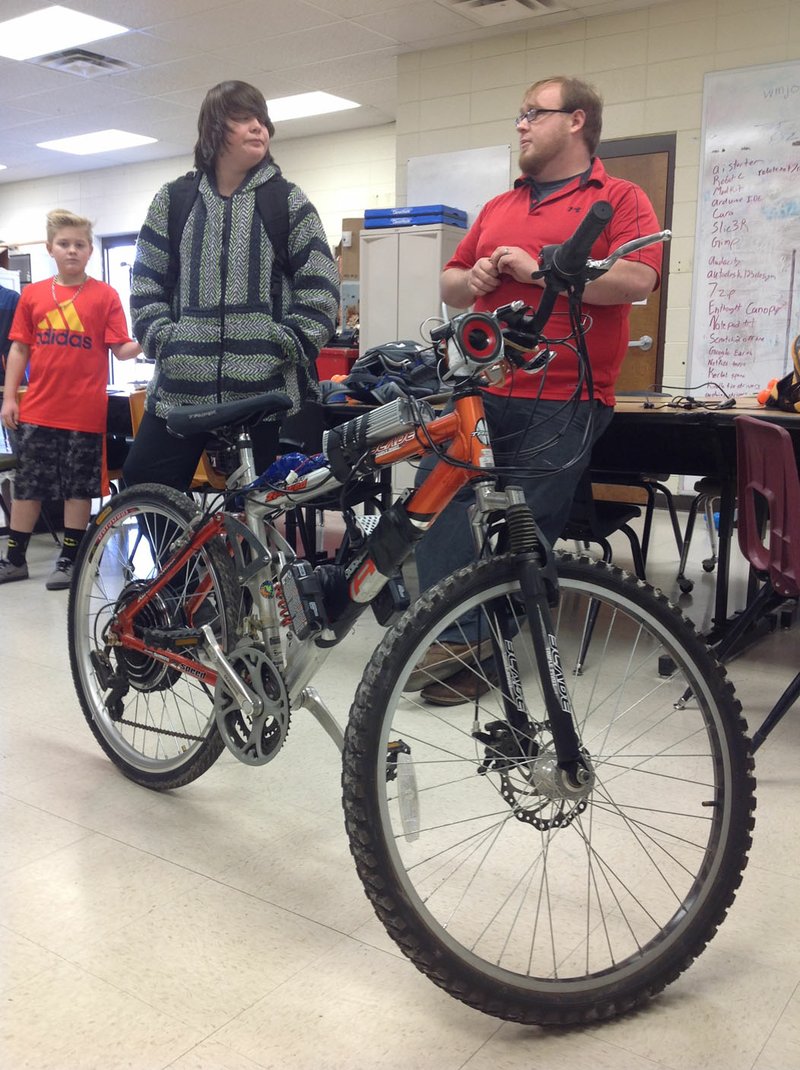BENTONVILLE -- Riding the bicycle cobbled together by some Washington Junior High School students is much like any other bicycling experience -- until, that is, hitting the throttle.
A 500-watt motor attached to the bike's rear wheel is powered by two rechargeable drill batteries mounted to the bike's frame. Activating the throttle causes the rear wheel to spin independently.
"So if you're going up a hill and you're tired and you pull the throttle, suddenly you feel like Superman," said Blake Matthews, a science and technology teacher at the Bentonville school.
Tim Sparacino, Washington's principal, called the bike "pretty cool," adding it's one of a number of unique projects going on at the school.
"We've got some kids in other classes that are maybe working toward some patents on things they've created, such as devices to help kids with physical challenges," Sparacino said. "It's really some amazing things kids can do when you ignite their passion and point them to a project that they care about."
That innovative mindset started in one or two classrooms and has become more of a schoolwide culture, he said. The school is trying to give students what they need to know academically while also nurturing their curiosity and interests in a way that keeps them engaged, he said.
"So it has an academic side and an attitude side," Sparacino said.
About a dozen of Matthews' students worked on the project in their spare time before and during school for about a week last month. They worked on it in groups whenever those groups had the time, Matthews said.
"I was basically project manager," he said. "I was communicating the plans and messages from each group to the next group, so the next group knew what the last group had done and what needed to be done next."
Matthews intervened at times when he deemed certain tasks too dangerous for the students to do on their own, "But the kids did almost all of the work," he said.
The bike consists of recycled parts from two broken bikes Matthews salvaged from his father-in-law's shed.
The project required some problem solving. The students' original battery pack consisted of three 12-volt batteries to achieve the 36 volts they needed, but the batteries they used were so heavy they nearly doubled the weight of the bike.
So the students configured two 18-volt lithium ion drill batteries, which Matthews had on hand, to get the needed voltage.
"It's easier to charge, and it's lighter," said Spencer Stevens, 14, an eighth-grader, about the batteries.
They made a mold for the batteries using melted plastic bottle caps and plastic shopping bags, then put screws through the plastic with the tips cut off to turn them into battery posts, Matthews said.
"Then they soldered those screws together with a wire to connect the two batteries in series. They put a 9-amp fuse in there for safety," he said.
Brodie Black, 14, worked on the wiring for the batteries.
"You have your throttle, and that goes to the speed controller, which tells the batteries how much to give to the motor," Brodie said. "You turn it on, you put the batteries in, press the button and it goes. It's pretty much that simple."
The brake is "a little bit wonky," but that's because the bike is made from scrap parts, Brodie said.
Students also had to remove and modify the bike's kickstand because the original one didn't fit with the larger axles of the bike's new wheels.
One student brought in a broken speaker students fixed and attached to the front of the bike. They melted down some more bottle caps and shopping bag sacks to make a mount for it. Anything with a headphone jack will plug into it.
"It's not very loud, but that's not the point. The point was, they did it," Matthews said.
Spencer, returning from his first ride on the bike Tuesday, declared, "That was fun."
The idea for an electric bike sprouted from a larger project Matthews and his students are working on, which is to create a scale model of the solar system that stretches from Bentonville to Berryville. They plan to use the bike with a trailer to move the planets to their respective locations.
The planets, made from plastic waste that's been melted and molded, will be installed on the campuses of schools in the area. The sun, which will be 60 feet in diameter, will be at the Amazeum in Bentonville. Mercury will be on Washington's campus. Matthews said he's arranging for other planets to be installed at schools in Bentonville, Rogers and Springdale.
The project grew from Matthews' realization students weren't grasping just how big -- and empty -- the solar system is. He said he hopes to have the solar system finished and installed by the end of this school year.
Metro on 02/07/2017
